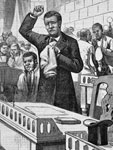An Enduring Spirit
From the Colonial Williamsburg: Past and Present Podcasts site—
"Edith Cumbo was a rare individual in colonial Virginia: a free African woman. Learn about her life and her stature in this interview with Emily James."
From the Colonial Williamsburg: Past and Present Podcasts site—
"Edith Cumbo was a rare individual in colonial Virginia: a free African woman. Learn about her life and her stature in this interview with Emily James."

The Bureau of Refugees, Freedmen, and Abandoned Lands, also known as the Freedmen's Bureau, was established by the War Department in 1865 to supervise all relief and education activities for refugees and freedmen after the Civil War. The Bureau was responsible for issuing rations, clothing, and medicine, and had custody of confiscated lands in the former Confederate states and other designated territories. This website contains an extensive collection of Freedmen's Bureau records and reports.
Included are more than 100 transcriptions of reports on murders, riots, and "outrages" (any criminal offense) that occurred in the former Confederate states from 1865 to 1868. There are also 30 links to records and indexes of labor contracts between freedmen and planters between 1865 and 1872; seven links to related sites; six links to marriage records of freedmen, 18611872; and more than 100 miscellaneous state record items concerning freedmen.
From the National Humanities Center website:
"'Then, thenceforward, and forever free.' Few public documents contain words more stirring than those from the Emancipation Proclamation. The process of Emancipation was momentous, tumultuous, exhilarating, and chaotic. Spirits soared and hopes were crushed as nearly four million black Southerners made the transition from slavery to freedom. How did they actually experience emancipation? What did they hope freedom would mean? How did they pursue it, and what obstacles did they face as they attempted to claim and secure freedom for themselves and their families? You will find some interesting answers to those questions in the remarkable photographs, letters, and eye witness accounts that we will discuss in this workshop."
This iCue Mini-Documentary describes the federal government's creation of the Freedmen's Bureau in 1865, to assist newly freed blacks with food, clothing, and jobs.

Textbooks often present a quick, uncomplicated overview of Reconstruction—a vast oversimplification of a time of social upheaval, tension, and violence. After Slavery: Race, Labor and Politics in the Post-Emancipation Carolinas, a joint project of Queen's University Belfast, the University of Memphis, and the University of London, provides primary sources that take a closer look at the time period.
Focusing on the themes of labor, race, and citizenship, After Slavery presents sources from North and South Carolina as examples of trends nationwide. A 2,500-word Introduction explores Reconstruction and the rationale for choosing the Carolinas as the project's focus. About the Project explains the structure and rationale behind the website's learning units.
The Learning Units form the heart of the site. Ten units cover topics including emancipation, mobilization, land and labor, black soldiers, conservative reactions, justice, gender, poverty and white supremacy, coercion and resistance, and the Republican Party. Each unit includes a 400-word introduction and six or more primary documents with three to eight discussion questions each. Units can be viewed online or downloaded as PDFs. An introductory essay explains the mission behind creation of the units, and Recommended Reading lists more than 80 books, 50 articles, and 15 primary sources.
As of December 7, 2012, other materials on the site are still content-light. Interactive Maps uses Google Maps to pinpoint only two events—the Hamburg Massacre and the Cainhoy Riot—with five to seven subevents included in each, as well as five-item lists of related sources.
Interactive Timelines includes three timelines with one-sentence descriptions on each item. Timelines look at general Reconstruction history as well as Reconstruction in North and South Carolina. Teacher Resources currently features links to more than 30 digital collections and exhibits, research tools, military records, audiovisual resources, and more. The section notes that lesson plans will be added in the future.
A valuable resource for teachers looking to complicate the textbook narrative on Reconstruction, and for teachers covering North or South Carolina history.